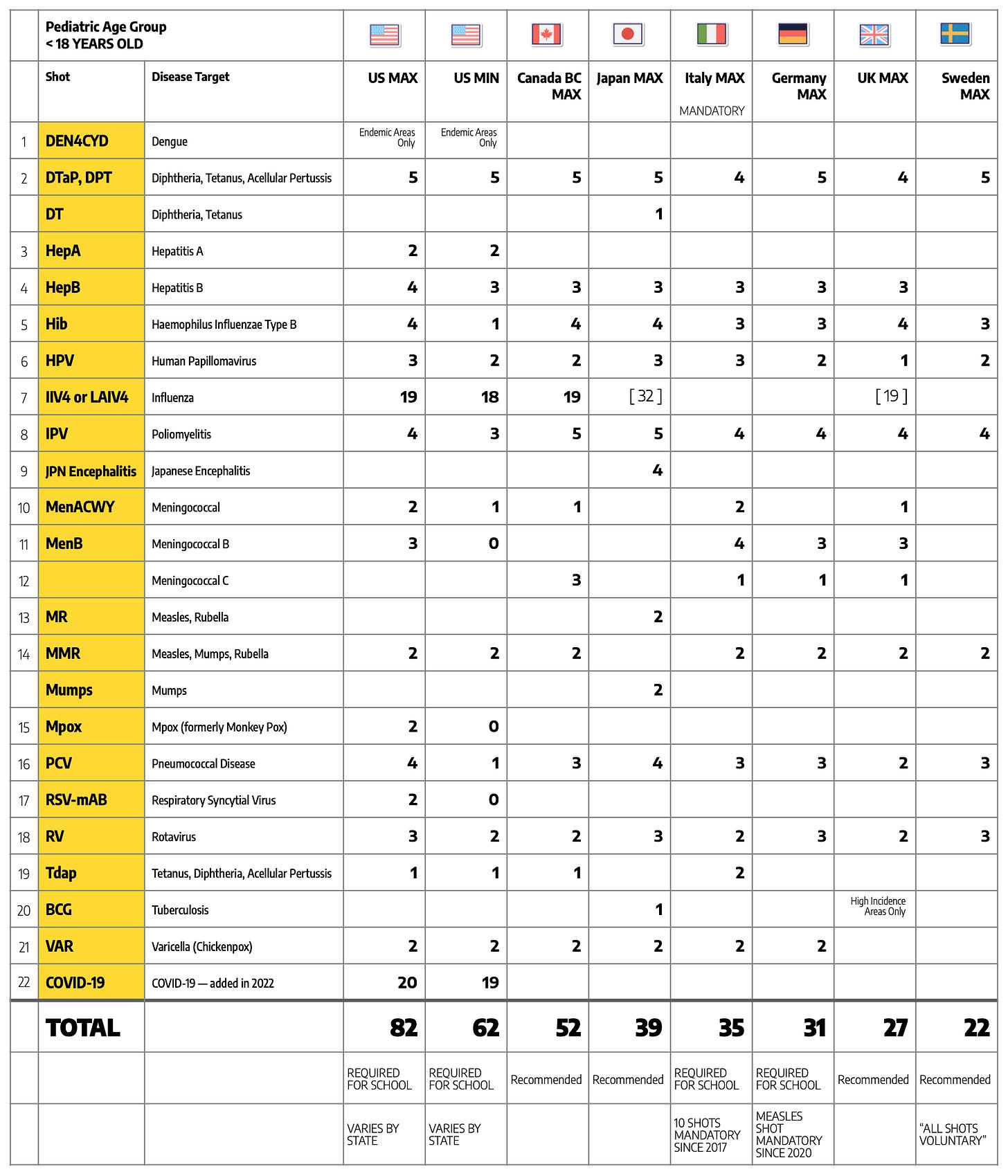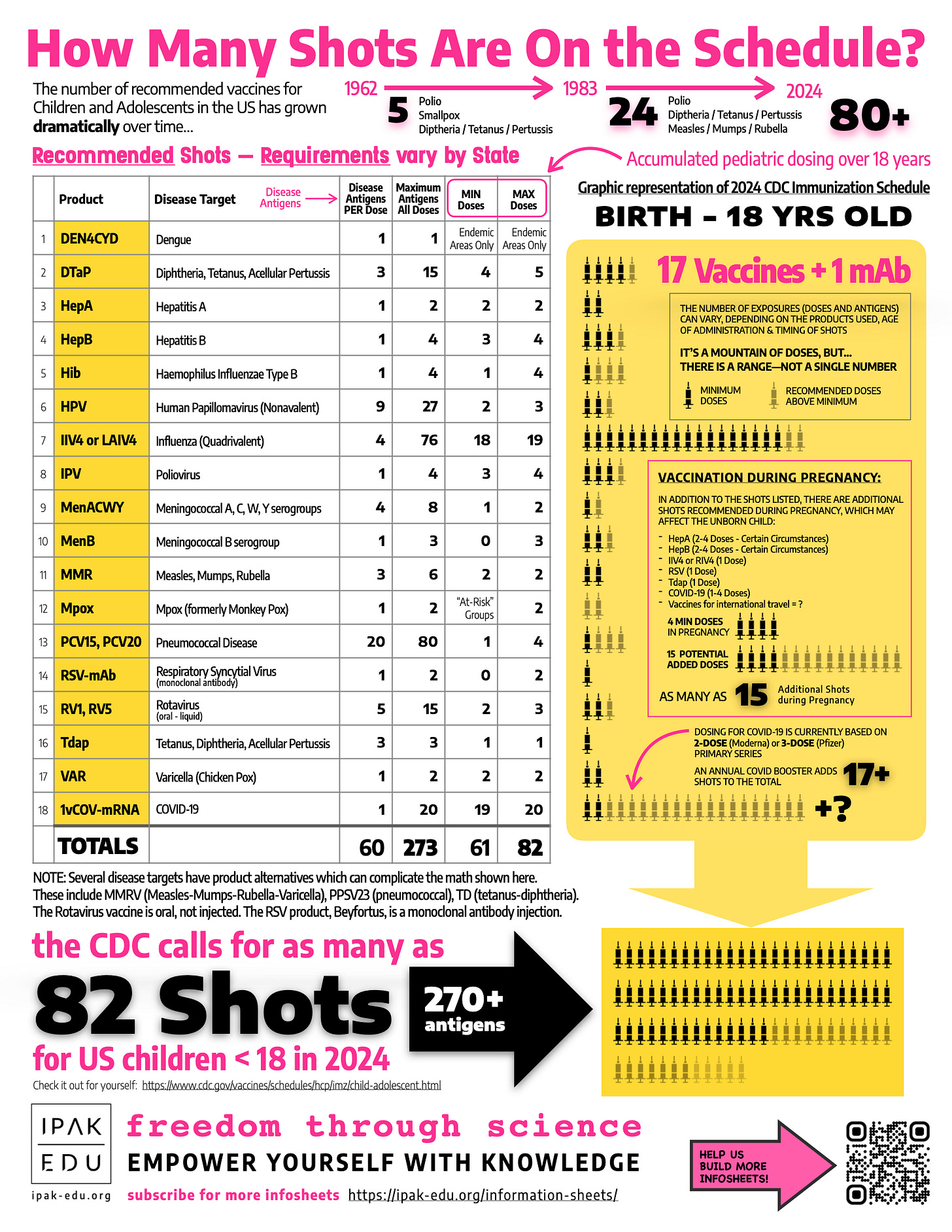It’s an American misconception: the US does things better than other countries.
To some extent, this is predictable; partly because the US public is constantly fed propagandized messaging through virtually all mass media outlets, but also because for too long, too few have sought out non-mainstream information sources.
As many have long realized (but many are still discovering), the vaccine space is highly managed, propagandized, and censored.
The COVID debacle—and the push for mandating untested, experimental, and demonstrably dangerous injections—has certainly impacted public perception on vaccination practices, and with good reason. The establishment has reacted, somewhat predictably, with outright censorship and lambasting skepticism with charges of being ‘anti-vaccine’.
The dipole of Pro vs Anti is, however, a rhetorical trap. The impact of the dipole is that it curtails critical thinking and any authentic consideration of evidence. Just as in contests and quests for ‘heroes’ and ‘villains’, the public is intentionally funneled, shamed, and diminished.
The message is clear: Don’t think—you don’t want to be the bad guy—pick a side.
The public image of vaccination policy in the US hinges on a narrative that is predicated on the assumption that the CDC is far and away the best and most trustworthy body on the topic, and the close alignment with organizations such as the WHO, the Bill and Melinda Gates Foundation, GAVI, and CEPI are ‘proof’ of global reliability and trust. The long-standing conflicts of interest and revolving door that ties pharma and the vaccine establishment to the CDC and FDA is expressly omitted or suppressed in the public narrative.
But even a cursory review of international vaccination practices reveals differences that run counter to that promulgated image.
Set aside, for the moment, the question of whether or not any of the injectible products on the CDC’s Child and Adolescent Recommended Immunization Schedule are ‘safe’ or ‘effective’. That is a worthy exploration in itself, but what does a simpler comparison to the international context reveal?
If the ‘science’ and ‘evidence’ supporting The Schedule is so irrefutable and self-evident, one might be inclined to believe that we should find a good degree of agreement, if not consensus.
What is the reality?
To explore this question, the requirements/recommendations for seven nations were compared: Germany1, Italy2, Canada3, Sweden4, Japan5, the UK6, and the US7.
For the purpose of this comparison, only policies applicable to children were considered.
It should also be noted that this comparison is basically structured around the shots used in the US Schedule. Other nations may and often do use different products and combination vaccines such as the pentavalent DTaP-IPV-Hib or the hexavalent DTaP-IPV-Hib-HepB.
A quick review reveals that, like the US Schedule, there is a range for number of shots, depending on various factors.8 Most national policies result in something similar to the US situation: a maximum number of doses and a lower, minimum number of doses.
For simplicity, we will focus only on the maximum doses outside the United States.
Here is a table compiling the totals.
The countries are arranged in descending order from left to right.
The table includes two US columns, to establish a range for minimum and maximum number of doses to compare with other nations.
Note that Canada’s provincial governments control vaccination policy, so for simplicity, only British Columbia is shown.
What follows are some of the key observations.
The US Schedule is a behemoth
The US Schedule maximum exceeds the next highest tally, that of Canada BC, by a factor of almost 1.6.
Even the tally for minimum US doses exceeds the Canada BC maximum by almost 20%.
The US minimum is double the maximums for Germany, the UK, and Sweden.
Moving across the table, the US Schedule maximum is more than double than the maximums for Japan, Italy, Germany, the UK, and Sweden.
Compared to the UK and Sweden, the US maximum calls for more than 3 times the number of shots, the precise factors being 3.03 for the UK and 3.72 for Sweden.
If the science on vaccination is so unequivocal, why on earth are there such discrepancies?
The Commonalities
Here are the aspects held in common.
All of the schedules in the seven countries compared recommend shots for these disease targets: Diphtheria, Tetanus, Pertussis, Polio, Measles, Rubella, Haemophilus Influenza, HPV, Rotavirus, and Pneumococcal Disease.
The Differences
The differences are revealing and worth reviewing.
Dengue: only recommended in the US, and even then, only in endemic areas
DT (Diphtheria-Tetanus): only used in Japan as a booster
Hepatitis A: only scheduled in the US
Influenza: recommended but not uniformly scheduled
Japanese Ecephalitis: only used in Japan
Meningococcal ACWY: only scheduled in the US, UK, and BC
Meningococcal C: only scheduled in BC, Germany, Italy, and the UK
MR (Measles-Rubella): only used in Japan, instead of MMR (Measles-Mumps-Rubella)
Mpox (Monkey Pox): only scheduled in the US
RSV (monoclonal antibody): only scheduled in the US
Tdap (Tetanus-Diphtheria-Acellular Pertussis): only used in the US, Italy, and BC
BCG (Tuberculosis): only in Japan, and the UK on a limited basis
Varicella (Chicken Pox): not scheduled in the UK or Sweden
COVID-19: currently only scheduled in the US
Influenza and COVID-19
Two shots dominate the tally for four of the seven countries that were compared.
The shots targeting influenza and COVID-19 account for around half of all shots called for by the US pediatric schedule and 36% of the shots for British Columbia.
Somewhat shockingly, the Japan Pediatric Society recommends a staggering 32 doses for influenza; although voluntary, if included, these doses push Japan into second place, at 71 shots, just below the US for total shots.
Similarly, including recommended doses for influenza pushes the UK maximum to 46. This would place the UK in 4th place.
The Mandatory Shots
Some, but not all of the countries compared require schedule compliance for school.
Of all the nations that were compared, Italy may have the harshest policy. According to the Italian Ministry of Health website, the vaccination law makes 10 shots mandatory.

The law provides for shocking penalties.

Germany, to a lesser degree, has made vaccination mandatory. Specifically, since 2020, the measles shot is required by law.
What may go unnoticed, however, is that a monovalent measles-only shot is no longer available.9 The Measles-Mumps-Rubella shot is thus, the default. So effectively, the MMR has been mandated for entry to kindergarten, day care, or schools. Employees at these facilities face similar requirements.
A single mandate for one disease target becomes a de facto mandate for three.
Sweden stands apart
Of all the nations considered, Sweden stands apart. Not only are the number of shots the lowest, government communication is clear: all of the shots are voluntary.
This statement isn’t buried deep in the weeds or veiled by gray language.
It’s literally the third sentence.
No exemptions.

So is the US > the World?
If you’re counting shots, the answer is an elephant-in-the-room “Yes”.
#questioneverything
Note: If readers observe any inaccuracy, please leave a comment. Revisions, if warranted, will be incorporated.
Information wants to be free—and over 90% of the content here is accessible to anyone. But everything takes care and time. If you like what you see, and you’re willing and able, consider leaving a tip. Every a little bit helps. Thank you!
https://www.rki.de/EN/Content/infections/immunisation/immunisation_node.html
https://www.epicentro.iss.it/en/vaccines/immunization-schedule-italy
https://www.canada.ca/en/public-health/services/provincial-territorial-immunization-information/provincial-territorial-routine-vaccination-programs-infants-children.html
https://www.folkhalsomyndigheten.se/the-public-health-agency-of-sweden/communicable-disease-control/vaccinations/vaccination-programmes/#children
https://www.jpeds.or.jp/uploads/files/20240220_Immunization_Schedule_english.pdf
https://www.gov.uk/government/publications/routine-childhood-immunisation-schedule
https://www.cdc.gov/vaccines/index.html
Refer to the Infosheet on the 2024 CDC Schedule, “How Many Shots Are on the Schedule?” for a breakdown of the tally.
Recommendations by the Standing Committee on Vaccination (STIKO) at the Robert Koch Institute, Epidemiologisches Bulletin 4, 2023, pp. 19-20.







